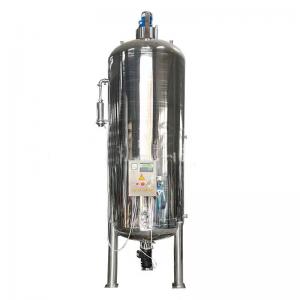

Add to Cart
3000L self-priming acetic acid deep fermentation tank acetic acid seed tank fermenter saccharification tank
Bioengineering Principles
Formation of acetic acid
To ensure the effective work of this microorganism, a very ideal
working environment is required, namely:
As long as the above conditions are met, the fermentation will proceed smoothly without any problems.
1. Overview
The first-level seed tank is a place for the growth of aerobic
microorganisms. This equipment introduces German technology and is
widely used in my country's vinegar industry and is well received
by users.
2. Advantages
This equipment consumes relatively little power, can maintain the
air required for fermentation, and can separate vapor and liquid
into even contact. 70% to 80% of the oxygen in the inhaled air is
utilized, making the conversion rate of alcohol into acetic acid
reach 96%. ~97%, giving priority to air compressors and other
common air systems, saving air compressors and air purification
system equipment. It occupies a small area, improves production
efficiency, increases conversion rate, saves 3% of investment
equipment, facilitates automation, saves labor, has a simple
structure, good dissolved oxygen effect, is hygienic, easy to
clean, and easy to operate.
3. The main structure is mainly divided into four parts
4. Inflating principle of self-priming first-level seed tank
Before starting the rotor, first immerse the rotor with
fermentation liquid, and then start the motor rotor to start
rotating in the stator. The liquid and air are thrown toward the
outer edge of the impeller under the action of centrifugal force,
and are evenly distributed through the guide plate of the stator.
Due to the rotation of the rotor, Due to the stirring effect, the
vapor and liquid form fine bubbles around the impeller, and mix and
tumble in the strong turbulence, spreading throughout the tank.
Therefore, the self-priming aeration device completes the aeration
while stirring. And because the air sucked by the rotor forms tiny
bubbles, the gas and liquid are closely and evenly combined and
contacted. The gas-liquid contact surface is constantly updated to
increase the dissolved oxygen coefficient, improve the utilization
of oxygen by microorganisms, and promote the healthy growth of
bacteria.
5. Technical parameters
Effective volume 200L |
Motor speed 1400 rpm |
Motor power 0.75kw |
Steam consumption 50 kg |
Overall size Ф700x1978 |
Material fermentation temperature 31°C |
Material cooling temperature to 32°C |
Material heating temperature 80°C |
6. Random accessories
7. Instructions for use and maintenance
Close all valves, open feed valve 2, open vent valve 7, feed to
70%-75% of the container, close feed and vent valve 7, open steam
valve 3, heat to 80°C and then close, open the feed valve Air valve
8 is connected to steam for heating and sterilization, with a
pressure of 0.095mpa and lasting for 30 minutes. Open the water
inlet valve 6, cool down to 32°C, and insert the acetic acid
bacteria from valve 1 according to the inoculation amount of 10%.
Open valve 9 and water outlet valve 10, turn on the self-priming
motor, adjust the air volume and flow to 1:0.1, about 2.4 cubic
meters, then open valve 11, aerate and culture at 30°C, the culture
temperature is 31°C, and the culture time is 22-24 hours.
Quality index: total acid (calculated as acetic acid) 1.5-1.8
g/100ml, Gram stain negative, no foreign bacteria, normal
morphology.
After processing, drain the contents of the tank, use an automatic
cleaning device as soon as possible, and rinse with warm water for
next use. Always pay attention to the working condition of the
entire equipment. It is strictly forbidden to start the motor
without adding cooling water to the sealing ring to avoid damaging
the sealing ring. The reducer must be refueled regularly.
Scrub the tank frequently to keep the surface clean and bright, so
as to achieve the purpose of durability.
tags:#acidfermentation #Fermentationtank #fermentertank #winefermentationtank #biofermenter
